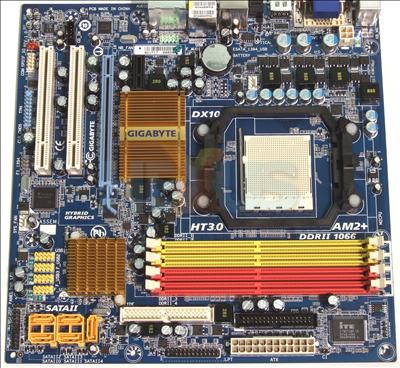
Sigmund Freud would most certainly call Albatron’s outer packaging, manly. Sporting a double barreled tank on a forest camo pattern, Albatron’s marketing people have come up with some truly unique eye grabbing appeal. Within the packaging we find our Albatron K8SLI board and a fairly light complement of extras. These include a user manual and quick reference installation guide, SLI bridge, Backup BIOS Module, one SATA cable, a SATA power adapter, IDE ribbon cables, I/O adapter plate and driver CD. Not that I was expecting a fat game bundle but while the essentials are most certainly included, the overall extra goodies seem slim.
The Board
As noted earlier, the Albatron K8SLI is a very compact board. This compactness doesn’t make much difference in the realm of practicality but it does make for a cleaner, neater appearance. The first thing you will notice on K8SLI, are the four DIMM slots positioned at the top of the board. This placement allows for a more narrow overall product. Each DIMM is capable of handling up to a gig stick of memory per slot as well as supporting dual channel. Just atop the DIMMS, is the FDD connector. I’ve seen some weird placement of mainboard components before but this one nearly tops the list. I don’t see this as a negative aspect of the K8SLI, as floppy drives are all but dead, hence my styling it ‘weird’ but still acceptable.
The processor socket is centrally placed as you would expect. A row of capacitors lines its edge on the I/O side. These capacitors don’t look to be any hindrance to the installation of an aftermarket cooler. In our testing we found no clearance issues with the few aftermarket AMD coolers we had on the shelf.
Along the right edge of the board we find all our cable connection points positioned admirably. As many of you know, I’m big about keeping cable clutter to an absolute minimum. Cable connections along the edge of a board is the best way to keep things as neat and clean as possible. Starting at the top edge moving down, we find the 24-pin ATX power connector, two IDE channels, four SATA posts and the front panel connectors at the very bottom. Positioning of the two internal USB connections just forward of the SATA posts shows a conscious effort on the part of Albatron for neat cable placement.






